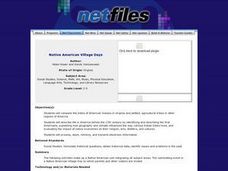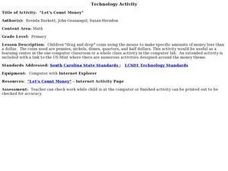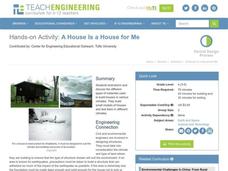Curated OER
Earthquakes Rock!
Young scholars study the main methods to measure earthquakes; the Richter Scale and Mercalli Scale. They make a model of a seismograph and investigate which structural designs are most likely to survive an earthquake.
Curated OER
Take Charge!
Students induce an electrical charge on various objects, and experiment with electrical repulsion and attraction. They define related vocabulary, play Bingo and complete a take-home quiz.
Curated OER
Tornado!
Students examine the characteristics and types of tornadoes. They discuss how they are formed, conduct an experiment with two liter bottles, analyze data and determine mean and median, and design a house to withstand tornado-force winds
Curated OER
Geography: Water, Water Everywhere
Young scholars discuss flooding and its causes. They view a Powerpoint presentation about floods and prevention methods. After creating a model with clay and pans, they investigate river behavior in various terrains with different...
Curated OER
Digestive System
Students analyze how the digestive system works by taking the food we eat and breaking it down for our bodies to use for various reasons. They list the major components of the digestive system and draw a diagram. They explain how...
Curated OER
How Should Our Gardens Grow?
Students examine different types of land use by humans and evaluate the ways land is used in their local community. They also consider the environmental effects of the different types of land use. Students assume the role of community...
Curated OER
Interactions Everywhere!
Learners examine interactions within the environment and environmental engineering careers. They discuss and view photos of natural and manmade environments, explore various websites, create a web to identify interactions between living...
Curated OER
Simple Machines and Modern Day Engineering Analogies
Young scholars apply the mechanical advantages and problem-solving capabilities of six types of simple machines (wedge, wheel and axle, lever, inclined plane, screw, pulley) as they discuss modern structures in the spirit of the...
Curated OER
Solid Waste Takes Over
Learners explore solid waste and its effects on the environment. They explain some of the major problems caused by waste disposal and the use of landfills. They suggest ways to reduce the amount of solid waste going into a landfill.
Curated OER
Splish, Splash, I was Takin' a Bath!
Students explore the causes of water pollution and its effects on the environment through the use of models and scientific investigation. In the accompanying activities, they investigate filtration and aeration processes as they are used...
Curated OER
It's Time to Make Time!
Students explore the evolution of time measurement, and explain the relationship of sunrise/sunset to length of daylight. They collect data and calculations to determine length of daylight during a given day.
Curated OER
Native American Village Days
Students research the tribes of American Indians in Virginia and settled, agricultural tribes in other regions of America. They explain how geography and climate influenced the way various Indian tribes lived, and evaluate the impact of...
Curated OER
"Let's Count Money"
Students participate in an interactive Internet activity that allows them to practice counting money. Students can work independently or cooperatively as they "drag and drop" coins using a mouse.
Curated OER
Electrifying the World
Students explore the fundamental concepts of electricity. They examine different circuit diagrams to study how electricity flows. They finish by creating their own simple circuit.
Curated OER
Move Your Muscles!
Learners, through teacher lecture and class discussion, explore the three different types of muscles in the human body and the effects of microgravity on these muscles. They explain what happens to muscles in outer space and describe the...
Curated OER
Naturally Speaking
Students identify the Earth's natural resources and classify them as renewable or non-renewable. They simulate the distribution of resources and discuss the fairness and effectiveness of the distribution. They identify ways that they use...
Curated OER
Just Passing Through
Students examine the functions of the kidney and its place in the urinary system. They discuss how astronauts go the bathroom in space, examine labeled diagrams of the urinary system, and draw a large scale drawing of the excretory...
Curated OER
What is Energy?
Young scholars define energy and identify the different types that exist. They identify places they see, hear or feel energy. They understand the role of engineering in finding and testing sources of energy for the production of...
Curated OER
Observing the Changes: The Warming of the North
After reviewing the causes and effects of climate change, students become observers for "Plant Watch," a program to monitor the effects of climate change on plants. Students record blooming and leafing dates for selected local species...
Curated OER
A House is a House for Me
Students evaluate the impact climates have on the building of structures. They research the different types of materials used to build houses in various climates and build small models of houses which are tested against different climates.
Curated OER
A World of Information
Students analyze data and statistics about countries around the world. They read graphs and charts, color a world map to illustrate the top ten statistics about the world, and write a paragraph to summarize their information.
Curated OER
A Closer look at Oil and Energy Consumption
Upper graders analyze basic concepts about the consumption, importation and exportation of the worlds oil production. They create several graphs to organize the data and draw conclusions about the overall use of oil in the world.
Curated OER
Strawkets and Weight
Learners investigate the effect that weight has on rocket flight. They construct a variety of straw-launched rockets that have different weights, observe what happens when the weight of a rocket is altered by reducing its physical size...
Curated OER
Ball Bounce Experiment
Students investigate different balls' abilities to bounce. They conduct a Ball Bounce Height Comparison and Ball Bounce Time Comparison, complete a worksheet, graph the results of their experiment, and answer investigating questions.























